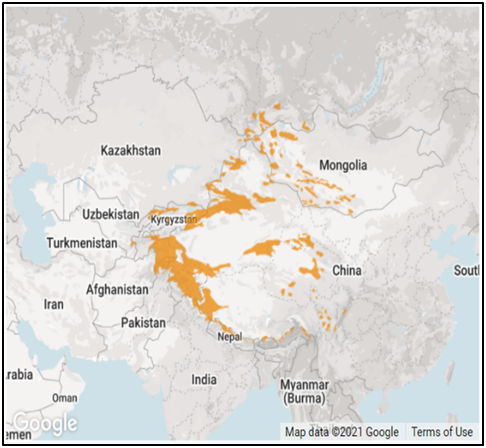Snow Leopards in India
16-01-2024
11:58 AM
1 min read

What’s in Today’s Article?
- Why in the News?
- About Snow Leopard
- About Padmaja Naidu Himalayan Zoological Park (PNHZP)
- News Summary

Why in News?
- The Padmaja Naidu Himalayan Zoological Park (PNHZP) in Darjeeling has made headlines for successfully breeding 77 snow leopards since the 1980s.
About Snow Leopard
- Snow leopard, also called ounce, are large Asian cat, classified as Panthera uncia in the family Felidae.
- It preys on animals such as marmots, wild sheep, ibex, and domestic livestock.
- Snow leopards act as an indicator of the health of the mountain ecosystem in which they live, due to their position as the top predator in the food chain.
- Habitat:
- Snow leopard is native to the mountain ranges of Central and South Asia.
- In India, their geographical range encompasses a large part of the western Himalayas including the territories of Jammu and Kashmir, Ladakh, Himachal Pradesh, Uttarakhand and Sikkim and Arunachal Pradesh in the eastern Himalayas.
- Threats to survival:
- Experts say there are 4,000 to 6,500 snow leopards remaining in the wild out of which around 500 are in India.
- The expansion of human settlement, especially livestock grazing, has led to increased conflict.
- Climate change is raising the average temperature across the snow leopard’s home range.
- Their lives are also threatened by poaching, driven by illegal trades in pelts and in body parts used for traditional Chinese medicine.
- Protection Status:
- IUCN Red list: Vulnerable
- CITES: Appendix I
- Wildlife (Protection) Act, 1972: Schedule I
- Conservation efforts:
- Project Snow Leopard was launched by the Government of India in 2009 to safeguard and conserve the population of snow leopards and their habitats by promoting conservation through participatory policies and actions.
- In 2020, under the SECURE Himalaya project of the United Nations Development Program (UNDP), a project to set up India’s first Snow Leopard Conservation Centre was started in Uttarkashi, Uttarakhand.
About Padmaja Naidu Himalayan Zoological Park (PNHZP)
- The PNHZP was formerly known as Himalayan Zoological Park and was established in August, 1958 in Darjeeling (West Bengal).
- The Park is striving for the maintenance of ecological balance in the Eastern Himalayas with the following objectives:
- Ex-situ Conservation and Captive Breeding of endangered Himalayan animal species.
- Educating, motivating and initiating awareness campaign among the local people as well as visitors on the importance of conservation of Himalayan Eco-system.
- Initiating applied research on animal biology, behaviour and health care.
- The zoo has been a pioneer for conservation breeding of endangered Eastern Himalayan Species in India.
- The first ex-situ conservation breeding program started in 1986 as a Snow Leopard conservation breeding project.
- The Red Panda project was started in the year 1990.
- It is the largest high-altitude zoo in the country.
News Summary
- The Padmaja Naidu Himalayan Zoological Park (PNHZP) in Darjeeling has made headlines for successfully breeding 77 snow leopards since the 1980s.
- This places the PNHZP next only to New York’s Bronx Zoo, which has produced 80 snow leopard cubs since it started breeding experiments with the species in the 1960s.
- Presently, the PNHZP has 14 snow leopards while the Bronx Zoo has 10.
- This success story at Darjeeling Zoo, however, has not been overnight. The conservation breeding programme for snow leopards, the first and the only in the country, was launched at Darjeeling Zoo in 1985.
- Four years later in 1989, the Conservation Breeding Centre (CBC), which is currently spread across five hectares at Topkeydara, recorded the first birth of a snow leopard.
- Since then, 77 snow leopards have been born in the zoo. While some died of natural causes, others were transferred to other zoos in the country.
- The Darjeeling Zoo has been the coordinating zoo for snow leopards in the country since 2007.
- Its breeding center practices highest biosecurity protocols that include regular screening of scats for parasites and deworming.
- Biosecurity protocols for all captive animals include blow flaming of shelters twice a month, using virucidal spray twice a month, daily use of UV lights, daily cleaning of shelters with disinfectants, burning of turmeric, use of potassium permanganate as foot baths, according to the zoo authorities.
Q1) What is the objective of the International Union for Conservation of Nature (IUCN)?
IUCN works to help countries mainstream nature into economic decisions, including making the private sector part of the solution for people and nature. IUCN monitors the impacts of climate change on nature, and guides the conservation and restoration of ecosystems to help mitigate and adapt to it.
Q2) What do you mean by CITES?
CITES (the Convention on International Trade in Endangered Species of Wild Fauna and Flora) is an international agreement between governments. Its aim is to ensure that international trade in specimens of wild animals and plants does not threaten the survival of the species.
Source: Darjeeling zoo’s success with snow leopards: Why wild cats are fussy breeders | Indian Express


